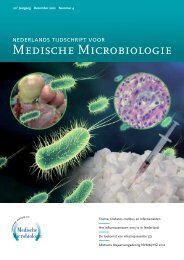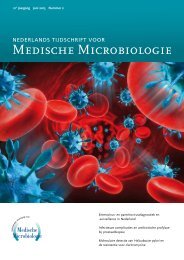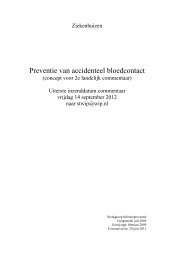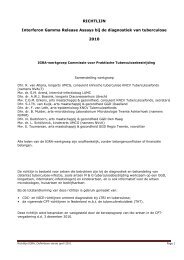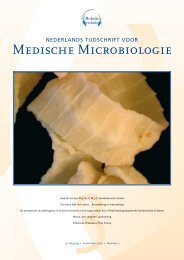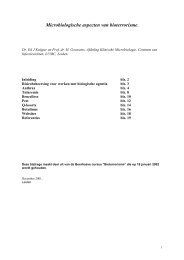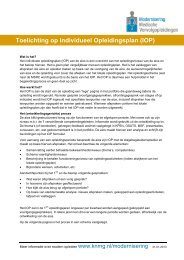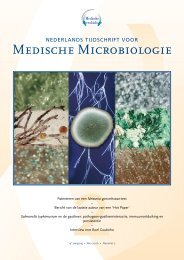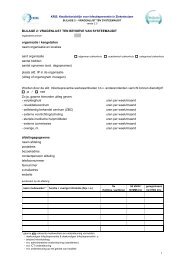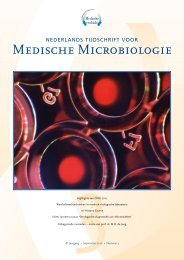Supplement bij veertiende jaargang, april 2006 - NVMM
Supplement bij veertiende jaargang, april 2006 - NVMM
Supplement bij veertiende jaargang, april 2006 - NVMM
You also want an ePaper? Increase the reach of your titles
YUMPU automatically turns print PDFs into web optimized ePapers that Google loves.
01.01<br />
Innate immunity of plants against fungi; arms race or<br />
balancing selection<br />
P.J.G.M. de Wit, M. Bolton, O. Boras, S. Gabriëls, J. van<br />
’t Klooster, I. Stulemeijer, J. Vossen, P. van Esse. E. Fradin,<br />
U. Ellendorff, I. Stergiopoulos, M. Joosten, B. Thomma.<br />
Wageningen University, Laboratory of Phytopathology,<br />
Wageningen<br />
Avr genes are supposed to have virulence functions in the<br />
absence of the corresponding resistance (R) gene. We have<br />
cloned four Avr and four Ecp genes of the tomato pathogen<br />
Cladosporium fulvum that all encode cysteine-rich peptides<br />
secreted by the fungus during infection of tomato leaves.<br />
Recognition of Avr and Ecp proteins is mediated by Cf<br />
proteins and leads to an innate immune or hypersensitive<br />
response (HR), co-ordinated death of a few host cells at<br />
the site of penetration by the pathogen. C. fulvum avoids<br />
recognition by its host by various mechanisms including:<br />
loss of Avr genes or point mutations, frame shift mutations<br />
or transposon insertions in Avr genes. Avrs are supposed to<br />
interact with a virulence target in the host that is sensed by<br />
Cf proteins that subsequently trigger an HR. Although all<br />
Avr and Ecp proteins are supposed to represent virulence<br />
functions, deletion of single genes do not significantly<br />
reduce virulence of the fungus. For two Avr proteins we<br />
have indications for their biological function. Avr4 is a<br />
chitin-binding protein that protects the fungus against<br />
basic plant chitinases. Avr4 proteins encoded by virulent<br />
alleles in strains of C. fulvum are no longer recognised by<br />
Cf-4 plants, but still bind to chitin, suggesting that chitinbinding<br />
by Avr4 could represent a defensive virulence<br />
function. The Avr2 peptide is secreted by C. fulvum into<br />
the apoplast of tomato leaves and, in the presence of the<br />
tomato extracellular, membrane-anchored Cf2 protein,<br />
triggers the HR that also requires the extracellular tomato<br />
cysteine protease Rcr3. Avr2 binds and inhibits Rcr3, and<br />
the Rcr3-Avr2 complex is subsequently recognized by the<br />
Cf-2 protein.<br />
01.02<br />
Innate immunity of insects<br />
J.M. Reichhart<br />
Strasbourg, France<br />
Drosophila mounts a potent host defence when challenged<br />
by various microorganisms. Molecular and genetic analyses<br />
of this defence have now provided a global picture of<br />
the mechanisms by which this insect senses infection,<br />
discriminates between various classes of microorganisms<br />
A B S T R A C T S<br />
Ned Tijdschr Med Microbiol <strong>2006</strong>; 4:<strong>Supplement</strong><br />
S 5<br />
and induces the production of effector molecules, among<br />
which antimicrobial peptides are prominent. A major<br />
result in these studies was the discovery that most of the<br />
genes involved in the Drosophila host defence are similar<br />
to genes implicated in the mammalian innate immune<br />
response. Recent progress in research on Drosophila<br />
immune defence and the newly discovered similarities or<br />
differences between Drosophila defence mechanisms and<br />
mammalian innate immunity will be discussed.<br />
01.03<br />
Poxvirus immune evasion strategies are linked to host<br />
tropism<br />
G. McFadden<br />
Robarts Research Institute, London, Canada<br />
Despite the eradication of smallpox as an extant human<br />
disease a quarter of a century ago, there remains<br />
considerable fear that variola virus, or other related<br />
pathogenic poxviruses like monkeypox, could emerge<br />
and spread in the human population again. Although<br />
remarkable advances have been made in our understanding<br />
in the molecular events of poxvirus infections, we are still<br />
mostly ignorant about why most poxvirus infections of<br />
vertebrate hosts usually exhibit strict species specificity, or<br />
how zoonotic poxvirus infections occur when poxviruses<br />
occasionally leap into novel host species. Unlike many<br />
other viruses, poxvirus tropism appears to be regulated<br />
not at the level of specific host receptors, but rather at intracellular<br />
events downstream of virus binding and entry.<br />
This seminar summarizes our current understanding of<br />
poxvirus tropism and host range, with specific emphasis on<br />
the prospects for exploiting host-restricted poxvirus vectors<br />
for vaccines or gene therapy and developing host-targeted<br />
oncolytic viral therapies for human cancers. Our lab has<br />
studied one particular poxvirus, myxoma virus, which<br />
exhibits strict species specificity for the rabbit. Targeted<br />
knockout analysis of specific myxoma virus genes has<br />
revealed new clues about the viral and host determinants<br />
of tropism and host range.<br />
01.04<br />
Bacterial innate immune evasion<br />
J.A.G. van Strijp<br />
UMC Utrecht, Eijkman-Winkler Institute, Dept. of Experimental<br />
Microbiology, Utrecht<br />
Upon entering the human body, bacteria are confronted<br />
with the sophisticated innate defense mechanisms of the




